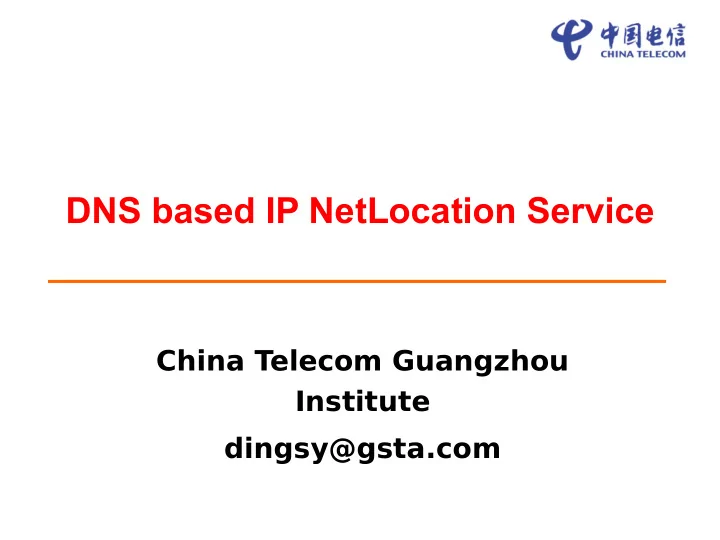

DNS based IP NetLocation Service China Telecom Guangzhou Institute dingsy@gsta.com
What is network location service To provide the target’s position in the network given its IP address It focuses on network location instead of geographic location DNS based Request Location network application Respond with its location Server target
What is network location The target’s location in the network, it provides information like: Which ISP the target belongs to Which AS it belongs to Which layer it lies at Which regional network it is in Not like Geographic location information which contains: City, Street, Building…
Why we need network location information Content Distribution Network optimization When a user want to get a service, CDN has to decide which server is nearest to the user The wider CDN covers, the more important location service is Peer to peer application optimization When a new peer joins the overlay network and launches a service, tracker has to determine which nodes are better to be used as its peers The most important information needed by tracker is about how peers are distributed in the whole network
Characteristics of NetLocation Information Facilitate proximity evaluation It does not need to be very precise. But still be quite useful given the rough information Location Information maintained by ISPs is precise enough for traffic optimization
Relevant work in IETF GeoPriv work group Defined a framework for geographic location service Try to provide a universal and comprehensive solution, thus a little bit complicated The request key is more than just IP address Has proposed to use HTTP and DHCP as transport protocols
Difference with GeoPriv Scope to serve GeoPriv tries to cover all possible applications NetLocation just provides IP based query Participants GeoPriv involves several participants such as targets(devices), LIS, rule makers and etc. NetLocation service emphasizes the simplicity � the main players are ISPs and Internet Registry Implementation difficulty Just for NetLocation service, GeoPriv seems too complicated
A concrete example in P2P downloading Some facts: P2P overlay network has millions of nodes distributed world-widely Tracker needs to get peer’s location information from different ISPs Tracker wants to use the same interface to communicate with different ISPs Tracker does not want complicated configurations for location service Tracker needs well-formed results to facilitate processing
With GeoPriv solution Issues How many LISs tracker needs to communicate How many interfaces tracker needs to implement for different ISPs Tracker needs to evaluate peers’ location very quickly. HTTP seems too heavy for this purpose. XML based processing is not light enough
With DNS based solution Almost zero configuration for tracker No particular protocol needed Fast proximity estimation using fixed and formatted location code instead of textual description DNS protocol is very light and easy to process
Solution of DNS based location service Use .nl.arpa for netlocation service . .arpa .com DNS request Application .nl.arpa .ip-addr.arpa API Location Resolver Service Zone 202.nl.arpa 101.nl.arpa 1.202.nl.arpa ISP Service Recipient Side Service Provision Side
Solution of DNS based location service Create a new domain under .arpa, say it nl.arpa The whole location records are organized into different zones in reverse DNS style For instance: location record for address 1.2.3.4 is written as ‘4.3.2.1.nl.arpa A location_info’ in database Clients which need location service will send a query with domain name as ‘4.3.2.1.nl.arpa.’ using resource type PTR
How should location information be presented Textual description Use plain text to describe the location like ‘China, Guangdong, Guangzhou, BAS1’ Easy to read for human but hard to handle for computer Numbered coding Use number to accurately define the location like ‘country_code.ISP_code.prov_code.city_code.dis trict_code.BAS_code’ Hard to read but easy to process for computer
Binary presentation for location information 16bit 16bit 16bit 16bit 16bit 16bit 16bit 16bit 16bit 16bit M M M M M O O O O O Country ISP Prov/State City District AS Agg_router Acc_router Reserved1 Reserved2 Give a number to each field instead of textual description Notation M: Mandatory O: Optional AS: Autonomous System Agg_router: Aggregator router Acc_router: Access router
Ascii Presentation in DNS response Hexadecimal digits for each field, separated by ‘.’ Example: 1A.2B.3C.4D.5E.0.0.0.0 will be the location information to appear in DNS response with Country code = 1A ISP code = 2B Province/State code = 3C City code = 4D District code = 5E Other codes = 0
Location Code format considerations A natural way to represent the target’s location in network The field can be empty if it can not be determined It is quite easy to evaluate the proximity given a collection of targets Current P2P systems are using such format for traffic optimization
Security and privacy consideration Access to NetLocaction service can be controlled by ipaddress-based filter on DNS Precision can be controlled by ISPs Location information just represents the position in the network, not necessarily geographic place Location information does not carry any identity of end user
Summary NetLocation service uses DNS as transport protocol NetLocation service uses a new domain called nl.appa The records are organized and processed like reverse DNS protocol NetLocation service uses fixed code format to represent the location NetLocation service implements access control by deploying IP filter on DNS servers NetLocation service is different from GeoPriv in terms of scope and implementation
Recommend
More recommend